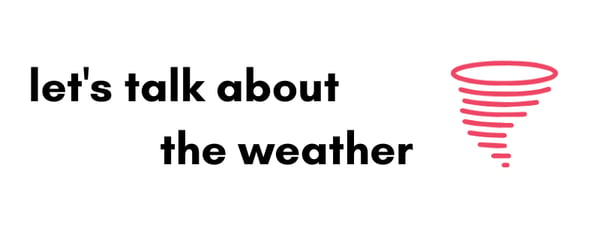Posted by Michele Redmon ● May, 2020
Tempest News | April 2020
Good morning! Today in Tempest News: An interview with Alan Steremberg, founder of Weather Underground, a look at how the pandemic is effecting weather forecasting and research, a curated list of the best weather-related resources for all, and what's behind the "megadrought" in the Southwest.
The pandemic's impact on weather forecasting
The United Nations’ World Meteorological Organization recently raised concerns about the COVID-19 pandemic’s effects on weather forecasting and climate research. While the lag in data collection was initially noted in fewer air traffic readings, it is also evident in developing nations, where weather data is historically collected manually. 'The break in the scientific record is probably unprecedented,’ one ecologist states.
the worst drought in 500 years
There have only been a handful of "megadroughts" in the United States (severe droughts lasting longer than 20 years). The most recent one is happening right now and has been ongoing since the year 2000, impacting much of the southwestern United States and northern Mexico. However, researchers have used tree rings to determine how it's different from those in centuries past.
Weather resources TO teach and entertain
Navigating a new normal of school closures and remote work? Check out this database of resources for weather-related curriculum, activities, and entertainment. From famous (and infamous) weather films and documentaries, to activities to inspire curiosity in humans of any age, this list is regularly updated and has something for everyone.

…..with Alan Steremberg, founder of Weather Underground.
Before COVID-19 became a pandemic, data scientists toiled away in relative obscurity, modeling things like weather, climate, and insurance risk.Today, as most of us shelter in place, the science of risk modeling has gone mainstream, with both a precise and broad range of information. These models can predict everything from the number of hospital beds and ventilators that may be needed, to deaths per day/per country to which counties across the US are actively social distancing. This has put some data scientists front and center, including University of Washington professor, Dr. Chris Murray.
Dr Murray’s COVID-19 US projection model has become the prediction map of the moment. He has appeared on virtually every major news outlet and his now famous map has been highlighted at White House press briefings. Murray and other data scientists are utilizing many of the same tools used to forecast weather, to model the spread and impact of COVID-19.
Murray told CNN, “ Just like a weather forecast, there are a lot of uncertainties that are changing all the time. Closer to the day, the better a weather forecast gets. We update our forecasts the same way, taking on board new events, like new stay at home orders. More data means definitely better forecasts, just like in weather.”

[Image of John Hopkins Coronavirus Resource Center Map showing the current 2.47 million confirmed cases of COVID-19 worldwide as of 4/20/2020.]
I wanted to understand more about the similarities between weather modeling and the pandemic maps, so I called Alan Steremberg, who founded Weather Underground. Here’s what he had to say:
Q: What connections (if any) are you making between the weather and this global health pandemic?
I don’t know that this pandemic has anything to do with weather. I’ve heard people speculate that warm weather will slow the virus but we haven’t seen that yet. However, the same kind of technology that helps forecast global weather has certainly proved beneficial in forecasting risks related to COVID-19. For example, the IBM Summit supercomputer recently ran simulations to analyze drug compounds that might effectively stop the virus from infecting host cells, ultimately identifying 77.
Q: What COVID-19 maps do you recommend? And why?
Originally, the coolest interactive graphic I saw was the New York Times editorial that allowed you to change the date when you began to stay at home to see how long we would likely be going to quarantine.
Otherwise, the John Hopkins COVID-19 map lagged a little behind, but they finally added a county view, and now with the county view it’s one of the best ones out there.
The Weather Channel maps are also amazing and they’ve added them to Weather Underground’s wundermap.
Q: Any others grab you?
One interesting graphic I saw tracked cell phones from spring break. It was frightening on a bunch of levels. Can you imagine we’re sending this much data to so many people?
I found another one that’s really almost perfect. The neat part about it is that you can see the curves as a percentage of population. It’s actually pretty amazing, more a chart than a map. You can drill down to country, state, or county views, and compare by day.
Then the one everyone is talking about is the University of Washington map with the curve. It’s a crazy projection of hospital bed utilization and resource utilization.
Interview by Ann Marie Gardner. Find her on Instagram @thenewweather
Back to: Newsletter
